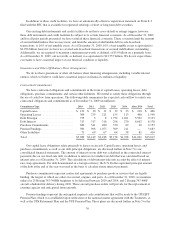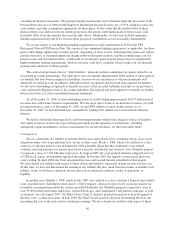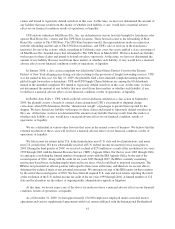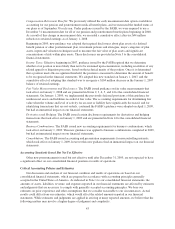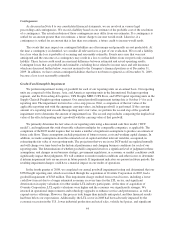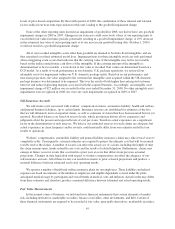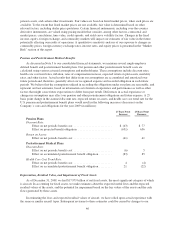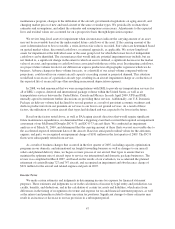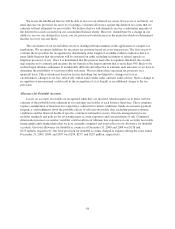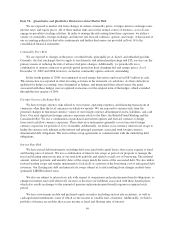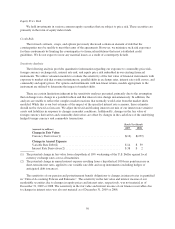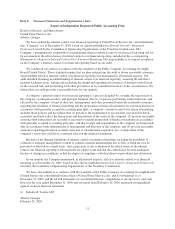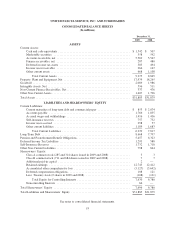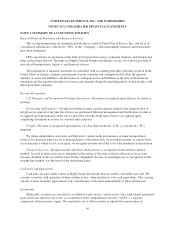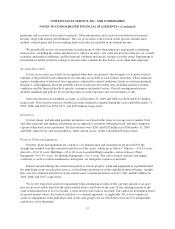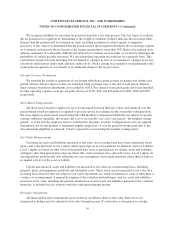UPS 2009 Annual Report Download - page 61
Download and view the complete annual report
Please find page 61 of the 2009 UPS annual report below. You can navigate through the pages in the report by either clicking on the pages listed below, or by using the keyword search tool below to find specific information within the annual report.Item 7A. Quantitative and Qualitative Disclosures about Market Risk
We are exposed to market risk from changes in certain commodity prices, foreign currency exchange rates,
interest rates, and equity prices. All of these market risks arise in the normal course of business, as we do not
engage in speculative trading activities. In order to manage the risk arising from these exposures, we utilize a
variety of commodity, foreign exchange, and interest rate forward contracts, options, and swaps. A discussion of
our accounting policies for derivative instruments and further disclosures are provided in Note 14 to the
consolidated financial statements.
Commodity Price Risk
We are exposed to changes in the prices of refined fuels, principally jet-A, diesel, and unleaded gasoline.
Currently, the fuel surcharges that we apply to our domestic and international package and LTL services are the
primary means of reducing the risk of adverse fuel price changes. Additionally, we periodically use a
combination of options contracts to provide partial protection from changing fuel and energy prices. As of
December 31, 2009 and 2008, however, we had no commodity option contracts outstanding.
In the fourth quarter of 2008, we terminated several energy derivatives and received $87 million in cash.
This transaction was reported in other investing activities in the statement of cash flows. As these derivatives
qualified for hedge accounting, were designated as hedges, and maintained their effectiveness, the gains
associated with these hedges were recognized in income over the original term of the hedges, which extended
through the first quarter of 2009.
Foreign Currency Exchange Risk
We have foreign currency risks related to our revenue, operating expenses, and financing transactions in
currencies other than the local currencies in which we operate. We are exposed to currency risk from the
potential changes in functional currency values of our foreign currency-denominated assets, liabilities, and cash
flows. Our most significant foreign currency exposures relate to the Euro, the British Pound Sterling and the
Canadian Dollar. We use a combination of purchased and written options and forward contracts to hedge
forecasted cash flow currency exposures. These derivative instruments generally cover forecasted foreign
currency exposures for periods of 12 to 24 months. Additionally, we utilize cross-currency interest rate swaps to
hedge the currency risk inherent in the interest and principal payments associated with foreign currency
denominated debt obligations. The term of these swap agreements is commensurate with the underlying debt
obligations.
Interest Rate Risk
We have issued debt instruments, including debt associated with capital leases, that accrue expense at fixed
and floating rates of interest. We use a combination of interest rate swaps as part of our program to manage the
fixed and floating interest rate mix of our total debt portfolio and related overall cost of borrowing. The notional
amount, interest payment, and maturity dates of the swaps match the terms of the associated debt. We also utilize
forward starting swaps and similar instruments to lock in all or a portion of the borrowing cost of anticipated debt
issuances. Our floating rate debt and interest rate swaps subject us to risk resulting from changes in short-term
(primarily LIBOR) interest rates.
We also are subject to interest rate risk with respect to our pension and postretirement benefit obligations, as
changes in interest rates will effectively increase or decrease our liabilities associated with these benefit plans,
which also results in changes to the amount of pension and postretirement benefit expense recognized each
period.
We have investments in debt and preferred equity securities (including auction rate securities), as well as
cash-equivalent instruments, some of which accrue income at variable rates of interest. Additionally, we hold a
portfolio of finance receivables that accrue income at fixed and floating rates of interest.
49


